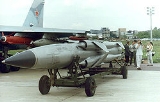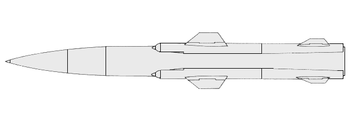
Moskit
Encyclopedia
The P-270 Moskit is a Russia
n supersonic
ramjet
powered cruise missile
. Its GRAU
designation is 3M80, and its NATO reporting name
is SS-N-22 Sunburn
. The missile system was designed by the Raduga Design Bureau during the 1970s as a follow up to the "SS-N-9 Siren
". The Moskit was originally designed to be ship launched, but variants have been adapted to be launched from land (modified trucks), underwater (submarine
s) and air (reportedly the Sukhoi Su-33
, a naval variant of the Sukhoi Su-27
). The missile can carry conventional and nuclear warhead
s.
The exact classification of the missile is unknown, with varying types reported; this has been due to the secrecy surrounding an active military weapon. It is one of the missiles known by the NATO codename SS-N-22 Sunburn. It reaches Mach 3 at a high altitude and its maximum low-altitude speed is M2.2, triple the speed of the subsonic American Harpoon. When such slower missiles, like the Harpoon or the French Exocet
are used, the maximum theoretical response time for the defending ship is 120–150 seconds. This provides time to launch countermeasures and employ jamming before deploying "hard" defense tactics such as launching missiles and using quick-firing artillery. But the 3M82 "Mosquito" missiles are extremely fast and give the defending side a maximum theoretical response time of merely 25–30 seconds, rendering it extremely difficult to employ jamming and countermeasures, let alone fire missiles and quick-firing artillery. The Moskit was designed to be employed against smaller NATO naval groups in the Baltic Sea
(Danish and German) and the Black Sea
(Turkish) and non-NATO vessels in the Pacific (Japanese, South Korean, etc.), and to defend the Russian mainland against NATO amphibious assault.
Variants of the missile have been designated 3M80M, 3M82 (Moskit M). The P-270 designation is believed to be the initial product codename for the class of missile, with the Russian Ministry of Defense GRAU indices (starting with 3M) designating the exact variant of the missile. The 3M80 was its original model. The 3M80M model (also termed 3M80E for export) was a 1984 longer range version of the missile, with the latest version with the longest range being the 3M82 Moskit M. The ASM-MMS / Kh-41 variant is the air launched version of the missile.
The missile has been purchased by the People's Liberation Army Navy
(China
) and India
.

: Inherited Soviet stocks and production.
: Bought Moskit to be employed on surface ships.
: Bought Moskit to be employed on surface ships.
Russia
Russia or , officially known as both Russia and the Russian Federation , is a country in northern Eurasia. It is a federal semi-presidential republic, comprising 83 federal subjects...
n supersonic
Supersonic
Supersonic speed is a rate of travel of an object that exceeds the speed of sound . For objects traveling in dry air of a temperature of 20 °C this speed is approximately 343 m/s, 1,125 ft/s, 768 mph or 1,235 km/h. Speeds greater than five times the speed of sound are often...
ramjet
Ramjet
A ramjet, sometimes referred to as a stovepipe jet, or an athodyd, is a form of airbreathing jet engine using the engine's forward motion to compress incoming air, without a rotary compressor. Ramjets cannot produce thrust at zero airspeed and thus cannot move an aircraft from a standstill...
powered cruise missile
Cruise missile
A cruise missile is a guided missile that carries an explosive payload and is propelled, usually by a jet engine, towards a land-based or sea-based target. Cruise missiles are designed to deliver a large warhead over long distances with high accuracy...
. Its GRAU
Grau
Grau is a German word meaning "gray" and a Catalan word meaning "grade". It may refer to:* BAP Almirante Grau , a De Zeven Provinciën class cruiser in service with the Peruvian Navy* Grau Käse, Tyrolean grey cheese...
designation is 3M80, and its NATO reporting name
NATO reporting name
NATO reporting names are classified code names for military equipment of the Eastern Bloc...
is SS-N-22 Sunburn
SS-N-22
SS-N-22 Sunburn is the NATO reporting name for two unrelated Soviet anti-ship missiles. Although the missiles were very different, distinguishing between them is difficult because their ship-mounted launching containers were identical. Confusion was exacerbated by the Soviet practice of mixing...
. The missile system was designed by the Raduga Design Bureau during the 1970s as a follow up to the "SS-N-9 Siren
SS-N-9
The P-120 Malakhit is a Russian medium range anti-ship missile used by corvettes and submarines. It has a range of up to . Introduced in 1972, it remains in service but has been superseded by the SS-N-22 Sunburn.-Development:...
". The Moskit was originally designed to be ship launched, but variants have been adapted to be launched from land (modified trucks), underwater (submarine
Submarine
A submarine is a watercraft capable of independent operation below the surface of the water. It differs from a submersible, which has more limited underwater capability...
s) and air (reportedly the Sukhoi Su-33
Sukhoi Su-33
The Sukhoi Su-33 is an all-weather carrier-based air defence fighter designed by Sukhoi and manufactured by KnAAPO. It is a derivative of the Su-27 "Flanker" and was initially known as the Su-27K. The aircraft was first used in operations in 1995, aboard the carrier Admiral Kuznetsov...
, a naval variant of the Sukhoi Su-27
Sukhoi Su-27
The Sukhoi Su-27 is a twin-engine supermanoeuverable fighter aircraft designed by Sukhoi. It was intended as a direct competitor for the large United States fourth generation fighters, with range, heavy armament, sophisticated avionics and high manoeuvrability...
). The missile can carry conventional and nuclear warhead
Warhead
The term warhead refers to the explosive material and detonator that is delivered by a missile, rocket, or torpedo.- Etymology :During the early development of naval torpedoes, they could be equipped with an inert payload that was intended for use during training, test firing and exercises. This...
s.
The exact classification of the missile is unknown, with varying types reported; this has been due to the secrecy surrounding an active military weapon. It is one of the missiles known by the NATO codename SS-N-22 Sunburn. It reaches Mach 3 at a high altitude and its maximum low-altitude speed is M2.2, triple the speed of the subsonic American Harpoon. When such slower missiles, like the Harpoon or the French Exocet
Exocet
The Exocet is a French-built anti-ship missile whose various versions can be launched from surface vessels, submarines, helicopters and fixed wing aircraft. Hundreds were fired in combat during the 1980s.-Etymology:...
are used, the maximum theoretical response time for the defending ship is 120–150 seconds. This provides time to launch countermeasures and employ jamming before deploying "hard" defense tactics such as launching missiles and using quick-firing artillery. But the 3M82 "Mosquito" missiles are extremely fast and give the defending side a maximum theoretical response time of merely 25–30 seconds, rendering it extremely difficult to employ jamming and countermeasures, let alone fire missiles and quick-firing artillery. The Moskit was designed to be employed against smaller NATO naval groups in the Baltic Sea
Baltic Sea
The Baltic Sea is a brackish mediterranean sea located in Northern Europe, from 53°N to 66°N latitude and from 20°E to 26°E longitude. It is bounded by the Scandinavian Peninsula, the mainland of Europe, and the Danish islands. It drains into the Kattegat by way of the Øresund, the Great Belt and...
(Danish and German) and the Black Sea
Black Sea
The Black Sea is bounded by Europe, Anatolia and the Caucasus and is ultimately connected to the Atlantic Ocean via the Mediterranean and the Aegean seas and various straits. The Bosphorus strait connects it to the Sea of Marmara, and the strait of the Dardanelles connects that sea to the Aegean...
(Turkish) and non-NATO vessels in the Pacific (Japanese, South Korean, etc.), and to defend the Russian mainland against NATO amphibious assault.
Variants of the missile have been designated 3M80M, 3M82 (Moskit M). The P-270 designation is believed to be the initial product codename for the class of missile, with the Russian Ministry of Defense GRAU indices (starting with 3M) designating the exact variant of the missile. The 3M80 was its original model. The 3M80M model (also termed 3M80E for export) was a 1984 longer range version of the missile, with the latest version with the longest range being the 3M82 Moskit M. The ASM-MMS / Kh-41 variant is the air launched version of the missile.
The missile has been purchased by the People's Liberation Army Navy
People's Liberation Army Navy
The People's Liberation Army Navy is the naval branch of the People's Liberation Army , the military of the People's Republic of China. Until the early 1990s, the navy performed a subordinate role to the PLA Land Forces. Since then, it has undergone rapid modernisation...
(China
China
Chinese civilization may refer to:* China for more general discussion of the country.* Chinese culture* Greater China, the transnational community of ethnic Chinese.* History of China* Sinosphere, the area historically affected by Chinese culture...
) and India
India
India , officially the Republic of India , is a country in South Asia. It is the seventh-largest country by geographical area, the second-most populous country with over 1.2 billion people, and the most populous democracy in the world...
.
Specifications

- Launch range, km:
- min 10
- max (3M-80E/3M-80E1) 120/100
- Missile flight speed: 2,800 km/h
- Missile cruising altitude: 20 m
- Launch sector relative to ship’s lateral plane, ang.deg ±60
- Launch readiness time, sec:
- From missile power-on till first launch: 50 s
- From combat-ready status: 11 s
- Inter-missile launch time (in a salvo), sec: 5
- Launch weight:
- 3M-80E missile 4,150 kg
- 3M-80E1 missile 3,970 kg
- Warhead type penetrator
- Warhead weight, kg 300
- Dimensions, m:
- Length 9.385
- Body diameter 0.8
- Wing span 2.1
- Folded wing/empennage span, m 1.3
Operators
: Original developer and primary operator of the Moskit.: Inherited Soviet stocks and production.
: Bought Moskit to be employed on surface ships.
: Bought Moskit to be employed on surface ships.

